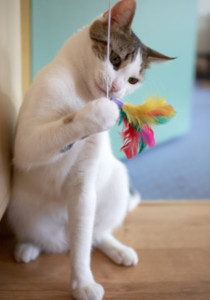Are you introducing a new cat into your home, but are unsure about how your other cat(s) will react? Oftentimes, they will become best buds, but it does take a few tricks to get them comfortable with one another.
If you introduce them too quickly or don’t give them the time and space to get properly acclimated, it could be a recipe for a rough relationship. If cats meet face to face right away, you might see an unpleasant side of your cat that you didn’t know they had, or simply a display of fear and protectiveness. They might react in a number of ways, from just sniffing or staring at one another to getting the claws out and hissing obscenities.
We’ve known many clients who have been through these nerve-racking first starts, so we’ve researched several ways you can create a a safe and positive experience when introducing a new cat to other cats.
What to expect:
In general, very gradual introductions work best. So, have patience. Be prepared for introductions to take anywhere from several days to a few weeks. Here’s how to reduce any conflict, and what to do if there is initial hostility:
1. Give Them Space
Your new cat not only has to adjust to other cat companions who don’t want to share their space at first, they also have to explore and get comfortable in their new living situation. It’s a lot of “new” all at once. To help acclimate without overwhelming, set up a nice room just for the new cat alone. Make sure he has his own litter box, food, water, scratch post, bed, and toys. Let him know that he has arrived at his forever home, with humans who love and care for him. Just make sure you spend equal amounts of time with your old cat. Believe it or not, cats can actually get pretty jealous.
2. Cats Who Eat Together, Stay Together
Separately feed the cats, but do so on opposite sides of the new cat’s door. Put the bowls a few feet apart at first (too close to the door and they might get upset at one another.) This trick allows them to get accustomed to one another’s smell while they partake in an activity they both enjoy. Gradually move the bowls closer and closer to the door until they are able to eat on opposite sides of the door without any displays of distress.
3. Scents First, Truce Second
Out of all the senses, cats use their sense of smell most in order to identify people, objects, and in this case, the fellow feline in the household. You’ll want to expose them to each other’s scents as much as possible. In order to do this, you can switch their living spaces for a few hours. This way, the old household members can get accustomed to the new cat’s smell and the new cat can get used to theirs and to the whole living space they’ll eventually have, all while spreading their scent into one another’s temporary territories. You can put them back after a few hours, and begin to do this once every day.
Another way to spread their scent is to get a towel or blanket and gently rub it on the new cat then bring it into the main living area for the old cats to get familiar with. You can also swap their beds and toys. Repeat this several times a day, and if you need to leave the house, be sure to put the cats back in their respective places. If this all goes well, you can try opening the door a bit while you’re home to supervise, so they can see one another.
4. Shake Paws, You Two
If the animals are responding well to the first few steps, then it is time for the big reveal! The best-case scenario is that they sniff and lick each other as a way of a happy introduction. The second best case is some growling or hissing, and a haughty sashay away from one or both of them. That’s okay too and is to be expected during this time.
The worst-case scenario is your cats showing signs of extreme agitation. Some signs of this will be a flattening of the ears, crouching, and growling. To prevent a rumble, clap your hands to make a loud noise, or throw something like a toy or light object to distract them. Don’t ever try to pick a cat up to stop a potential fight, or you could end up as collateral damage. If they persist with an attack stance, herd them into separate areas of the living area to calm them down. You can try to reintroduce them whenever they’ve calmed down, which can take just a couple hours to a full day. Make sure you are giving attention to both cats the entire time this process is taking place.
If they didn’t bond right away, repeat steps 1, 2, and 3 until you feel they’re more comfortable for step 4 again. Keep their routines similar, and make sure each cat has a safe space to hide when they get stressed or frightened. If, after several weeks of going through these steps of reintroduction, the cats are still not getting along, it’d be best to consult an animal behaviorist or your vet.






